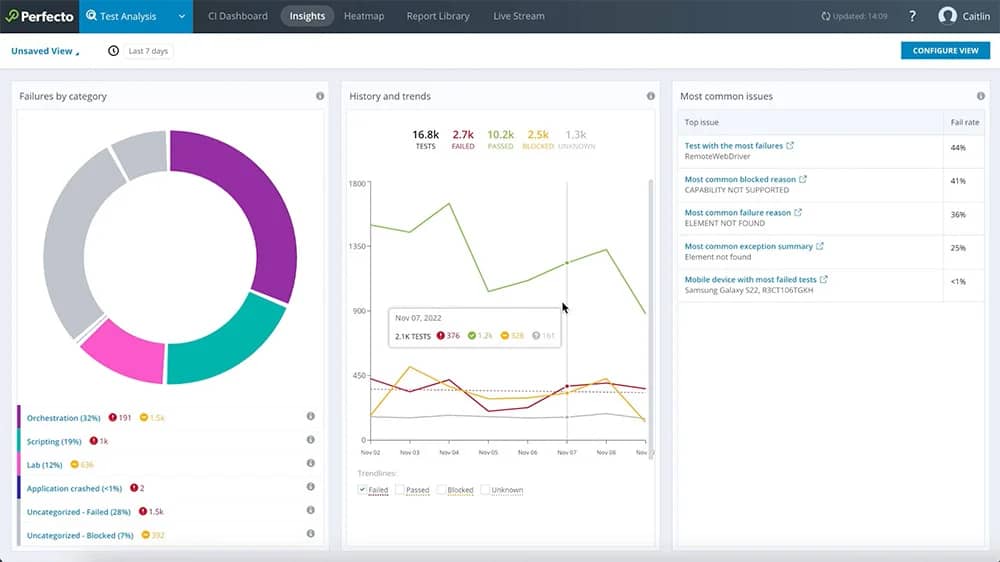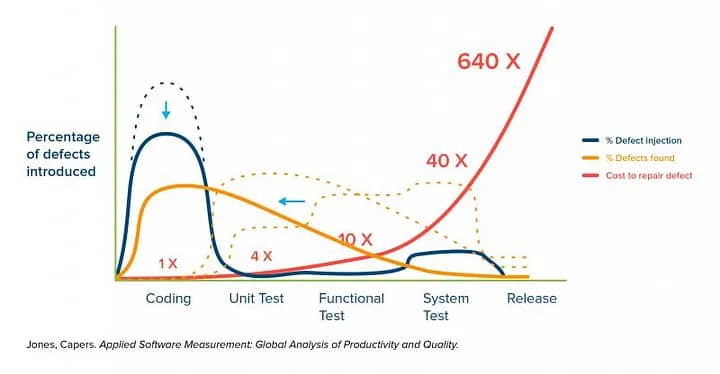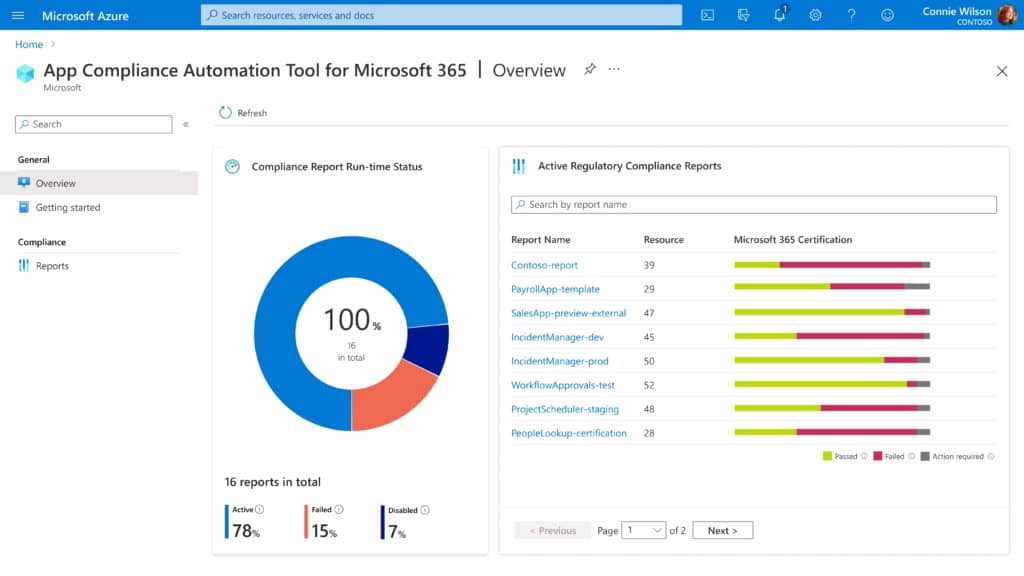Last Updated on 2024-10-11
In a tech landscape evolving rapidly, staying informed is crucial for anyone involved in software development.
Whether you’re a seasoned tester, a developer, or a tech enthusiast, join us as we explore cutting-edge trends shaping software testing in 2024.
Discover how AI and machine learning integration, the evolution of DevOps, and continuous testing are reshaping the future of software testing.
Get ready to adapt, innovate, and elevate your software testing game in 2024 and beyond. Let’s dive into the future of software testing together!
Paving the Way for the Future: Introduction to Software Testing Trends
From the increased adoption of artificial intelligence and machine learning in testing processes to the seamless integration of DevOps and continuous testing, we’ll delve into the innovative strategies organizations and professionals employ to deliver unparalleled quality and efficient software and other apps.
As technology continues to advance relentlessly, software testing is undergoing a profound evolution.
We will unravel the intricate tapestry of software testing trends, shedding light on the transformative developments shaping the industry in 2024.
The Evolution of Testing Technology in the Industry
Technology is incessantly advancing, and with it, the significance of software testing. Once seen as a mere bug-hunting phase looking for software flaws, software testing has sculpted itself into the core of quality software delivery.
It’s thrilling to watch the entanglement of new technologies raising the bar for businesses to master efficient, robust, and faster delivery practices.
In the early days of the tech industry, testing was often an afterthought, conducted manually and primarily focused on identifying bugs or errors.
However, as software complexity increased, the limitations of manual testing became apparent. This led to the advent of software automation testing, a significant milestone that revolutionized the testing landscape.
Automated testing accelerated the testing process and improved accuracy and repeatability.
Test automation frameworks and scriptless automation testing emerged, allowing developers and testers to script test cases, execute them efficiently, and identify defects early in the development cycle.
The rise of agile, a software development methodology, further transformed testing practices. Agile emphasized iterative development and collaboration, prompting testing integration into the development process rather than treating it as a separate phase.
This shift towards continuous testing paved the way for faster release cycles and increased responsiveness to changing requirements.
Integrating artificial intelligence (AI) and machine learning (ML) into testing processes has brought about another paradigm shift in recent years.
AI-driven testing tools can analyze vast amounts of data, identify patterns, and predict potential issues, enhancing the efficiency and effectiveness of testing efforts. Testers can now focus on complex scenarios while leaving repetitive tasks to AI-powered tools.
The evolution of testing in the tech industry has also seen a closer alignment with DevOps practices.
The collaboration between development and operations teams has led to the emergence of DevOps testing, emphasizing continuous testing and integration throughout the entire software development lifecycle.
This approach leverages tools for testing, which facilitates seamless integration and delivery pipelines. These DevOps tools for testing ensure that testing is automated, continuous, and integrated with other DevOps practices, providing rapid feedback and enabling quicker resolution of issues. As a result, the synergy between development and operations enhances overall software quality and accelerates time-to-market.
Looking ahead, the evolution of testing in the tech industry is poised to continue. The emphasis on shift-left testing, where testing activities are conducted earlier in the development process, and the growing importance of security testing underscore the industry’s commitment to delivering high-quality, secure, and resilient software.
Setting the Stage for 2024 Innovations
As we gaze into the future, 2024 will be a captivating year for tech innovations. New technologies and methodologies set the stage for a seismic shift in conceptualizing and executing software testing. Anticipate a landscape where software testing is pivotal in delivering cutting-edge applications with exceptional user experiences. In this digital epoch, staying ahead means embracing trends that promise to redefine quality and efficiency benchmarks.
Software Testing Trends for 2024
Let’s not stall any further and find out the latest software testing technologies for the year 2024.
1. AI and Machine Learning: The New Frontier in Software Testing
Artificial Intelligence (AI) and Machine Learning (ML) represent the cutting edge of computational capabilities, enabling machines to learn, adapt, and make intelligent decisions.
Integrating AI and ML in software testing is not merely a trend; it represents a seismic shift that brings efficiency, accuracy, and adaptability to the testing process. Their ability to automate, optimize, and adapt testing processes positions them as invaluable tools in the pursuit of delivering high-quality software in an era of rapid technological advancement.
Transforming Test Automation with Artificial Intelligence
Artificial Intelligence (AI) revolutionizes how automated tests are designed, run, and managed. Imagine your testing suite becoming smarter with each execution, pinpointing potential problems with uncanny precision.
AI-enhanced automation testing tools can now understand your application’s context, dynamically adapt tests, and analyze results with minimal human intervention. This means you can expect significantly reduced test maintenance and the ability to catch bugs before they become costly. An era of intelligent automation is upon us, transforming the testing landscape with robust, self-learning systems.
This is a web application dashboard of an AI-driven test automation tool called TestCraft by Perfecto.

Leveraging Machine Learning for Predictive Analysis and Quality Assurance
In the realm of quality assurance, Machine Learning (ML) is akin to possessing a crystal ball, offering predictive insights that allow for proactive decision-making. By leveraging ML algorithms, development teams are endowed with the power to analyze vast datasets, predict outcomes, and pre-emptively rectify issues, thereby elevating the reliability and robustness of software products.
These ML-driven systems aid in identifying patterns that escape the human eye, ensuring meticulous test coverage and a seamless user experience. Predictive analysis is becoming indispensable to a refined quality assurance strategy that keeps your software consistently ahead of the curve.
2. Shift Left Testing: Accelerating Time to Market
Shift Left Testing is a paradigm shift in the software development lifecycle that involves moving testing activities to earlier stages, typically starting in the development phase. This proactive approach holds the key to accelerating time to market by fostering collaboration, early defect detection, and overall efficiency.
Integrating Top Software Testing Trends into the Early Stages of Development
The narrative of software development is being rewritten with a ‘shift-left’ approach to testing. Integrating testing early in the development cycle isn’t just a tactful move; it’s strategically imperative. By embedding testing procedures at the onset, developers can identify discrepancies when they are least costly and most manageable to fix.
This proactive approach paves the path for a more stable and reliable codebase, ensures a cohesive developer-tester collaboration, and accelerates the route to a market-ready product. Transitioning to this methodology isn’t just about catching bugs—it’s about nurturing a culture of quality and excellent coding experience from the get-go.
Defects are introduced during coding, which can cause failures in production and result in high costs. Early feedback, detection, and removal of defects significantly reduce the cost of defect removal. This is shown in the diagram derived from Jones Capers’s book Applied Software Measurement.

The Impact of Shift Left on Continuous Integration and Delivery (CI/CD)
Shift-left testing transforms the CI/CD pipeline, exemplifying the adage ‘prevention is better than cure.’ It ensures that testing isn’t a conclusive checkpoint but an integral part of the development lifecycle. Embedding testing into each commit and pull request leads to a more resilient CI/CD process where issues are detected and resolved instantly. This paradigm shift means a smoother delivery pipeline with fewer roadblocks, enabling faster time-to-market and a higher caliber of software releases. By shifting left, the CI/CD pipelines don’t just deliver code; they deliver confidence.
One of the challenges with automated testing is how to scale out to process potentially hundreds or thousands of tests in your CI/CD pipeline. Once you start to scale up, you will need to look at using a test orchestration solution like Testery.
3. DevSecOps: Merging Security with DevOps
Merging security with DevOps in 2024 is a response to the evolving threat landscape, the need for faster and more iterative development cycles, and the recognition that security is a shared responsibility. This trend aims to create a more secure software development process by fostering collaboration, leveraging automation, and addressing security considerations from the outset of the development lifecycle.
Empowering Teams to Develop Secure Software at Speed
DevSecOps is a buzzword and a strategic movement that empowers teams to bake security into their software from the ground up. Taking a DevSecOps approach means security checks become an integral, automated part of every phase of the software development lifecycle.
This ensures that developers can maintain their pace without compromising on security, which was often considered a bottleneck in the past. Through tools and practices that facilitate early detection and mitigation of vulnerabilities, DevSecOps helps teams deliver secure software at the speed of Agile and DevOps—fulfilling the essential demand for swift yet secure software releases in the digital era.
The Role of Automated Security Protocols in DevSecOps
Incorporating automated security protocols within the DevSecOps framework is akin to deploying a vigilant guardian within the CI/CD pipeline. These protocols are pivotal in enforcing consistent security benchmarks across the development lifecycle, vigilantly scanning code commits, containers, and cloud configurations.
As they are triggered automatically, they ensure each piece of the software puzzle meets stringent security criteria without manual oversight, significantly reducing the chances of human error and oversight. This automated vigilance fortifies the software against emerging threats and instills a culture where security is everyone’s responsibility.
Ultimately, the role of automated security protocols in DevSecOps isn’t just operational—it’s transformative, fostering a secure-by-design philosophy.

4. IoT and RPA: Expanding the Boundaries of Test Automation
IoT (Internet of Things) and RPA (Robotic Process Automation) are rapidly expanding the boundaries of automation testing, creating new challenges and opportunities.
Expanding test automation boundaries with IoT and RPA involves addressing the complexities introduced by diverse ecosystems, scalability, security, and real-time data in IoT, as well as end-to-end process automation, UI interactions, data integration, and error handling in RPA.
Adapting and enhancing test automation frameworks to encompass these challenges is crucial to ensure the reliability and effectiveness of IoT and RPA solutions in today’s interconnected and automated world.
Exploring the Scope of IoT Testing for Connected Devices
The Internet of Things (IoT) presents an ever-expanding frontier for test automation as connected devices proliferate at an unprecedented scale. The scope of IoT testing transcends beyond functional verification, encompassing the nuanced complexities of real-world scenarios these devices operate within.
Testers must ensure the software’s functionality is seamless, communicates flawlessly across diverse networks, maintains data integrity, and withstands potential cybersecurity breaches. As IoT devices become integral to daily life, how they are tested must evolve to ensure reliability, performance, and security in the interconnected fabric of smart technology.

Unleashing the Potential of RPA for Streamlined Workflow Testing
Robotic Process Automation (RPA) is the game-changer for streamlining workflow testing. RPA tools mimic human interaction to perform repetitive and rule-based tasks across applications, significantly trimming down the time and resources devoted to manual testing and boosting QA function.
The potential of RPA lies in its meticulous precision and tireless work capacity, which, when unleashed, can enhance test coverage and accelerate cycle times. This infuses a new level of efficiency into the QA process, allowing teams to focus their expertise on complex test scenarios that demand human ingenuity.
By integrating RPA, your team can fast-track the testing process and achieve a new standard of accuracy and consistency in every software release.
5. Performance Engineering: More than Just Testing
Performance engineering is a process that goes beyond traditional performance testing. It aims to optimize a software system’s overall performance and efficiency throughout its entire development lifecycle. This approach is holistic, proactive, and collaborative, integrating performance considerations throughout the software development lifecycle.
It involves more than just testing; it also includes optimization, collaboration, and continuous improvement. That is why it is a comprehensive strategy for delivering software systems that have high performance.
The Rise of Cloud Performance Engineering
Cloud Performance Engineering is ascending as a cornerstone practice in modern software development, spotlighting performance as a metric and a user experience. In an era where latency can lead to loss of user engagement or revenue, engineering cloud-based applications for optimal performance is critical.
This discipline extends beyond traditional testing to embrace a holistic approach that factors in infrastructure, service models, and scalability. By emphasizing performance at the core of cloud service design, development teams can deliver systems that meet and exceed user expectations, regardless of load or demand, ensuring satisfaction and business continuity.
Here is a numbered list outlining critical components or steps involved in cloud performance engineering:
- Performance Modeling:
- Develop models to simulate and predict system behavior under different conditions.
- Consider factors such as user load, data volumes, and network latency.
- Scalability Assessment:
- Evaluate the system’s ability to scale horizontally and vertically in response to increasing user demands.
- Test scalability under various load levels to identify potential bottlenecks.
- Cloud Resource Optimization:
- Optimize resource allocation, considering factors like virtual machine configurations, storage, and network settings.
- Leverage cloud-native services for efficiency and scalability.
- Network Performance Testing:
- Assess the impact of network latency, bandwidth, and communication protocols on application performance.
- Test under various network conditions to ensure optimal user experience.
- Data Storage and Retrieval Optimization:
- Evaluate the performance of data storage solutions in the cloud.
- Optimize database queries, indexing, and caching mechanisms for efficient data retrieval.
- Load Testing and Stress Testing:
- Conduct load tests to simulate expected user loads and identify performance thresholds.
- Perform stress tests to determine system behavior and uncover failure points under extreme conditions.
- Distributed Systems Testing:
- Test the performance of distributed components and microservices.
- Assess inter-service communication, data consistency, and overall system resilience.
- Security Performance Testing:
- Integrate security considerations into performance testing to assess the impact of security measures on overall performance.
- Evaluate the system’s ability to withstand security threats under load.
- Continuous Performance Monitoring:
- Implement real-time monitoring tools to track key performance indicators (KPIs).
- Monitor resource utilization, response times, and other relevant metrics continuously.
- Auto-scaling Configuration:
- Configure auto-scaling policies to dynamically adjust resources based on demand.
- Implement policies for automated scaling up or down in response to changing conditions.
- Incident Response Planning:
- Develop incident response plans for addressing performance issues promptly.
- Establish protocols for identifying, analyzing, and mitigating performance-related incidents.
- Continuous Improvement:
- Analyze performance testing results and monitoring data to identify areas for improvement.
- Iterate on performance engineering strategies based on lessons learned from real-world usage.
- User Experience Optimization:
- Prioritize optimizing user-centric performance metrics, such as page load and response times.
- Consider user experience as a key performance indicator.
- Cost Optimization:
- Evaluate the cost implications of cloud resources and performance optimizations.
- Optimize resource usage to minimize costs while maintaining optimal performance.
- Collaboration and Communication:
- Foster collaboration between development, operations, and testing teams.
- Ensure clear communication of team performance goals, metrics, and optimization strategies.
Implementing these critical components ensures a comprehensive and effective cloud performance engineering strategy, addressing key aspects of scalability, optimization, security, and continuous improvement.
Focusing on User Experience Metrics and Business Continuity
User Experience (UX) metrics have become the lifeblood of performance engineering, with the user’s journey at the epicenter of every testing strategy. In today’s performance engineering landscape, the focus has extended to ensure that applications are fast and responsive and provide an enriched, engaging experience.
Businesses can directly correlate application performance with customer satisfaction and loyalty by monitoring real user metrics such as load times, interaction readiness, and visual stability.
Moreover, this strategic focus on UX ensures business continuity, as sustained performance leads to consistent service delivery and positive customer feedback, which maintains the operational heartbeat of the digital enterprise.
6. The Importance of Multi-Device and Cloud-Native Testing
In the digital age, testing has gone beyond traditional methods. Multi-device and cloud-native testing have become essential practices. Multi-device testing ensures that the user experience is consistent and positive across different mobile devices.
On the other hand, cloud-native testing aligns with modern mobile app development practices, ensuring that all applications perform optimally in dynamic and scalable cloud environments. Together, these testing approaches deliver resilient, high-performing, and user-friendly applications in today’s ever-evolving technology ecosystem.
Addressing the Challenges of Cross-Platform Compatibility
The digital world’s vast expanse of devices and platforms presents a daunting challenge for software testing – ensuring cross-platform compatibility. With a plethora of operating systems, browsers, and device configurations, it’s imperative to certify that applications deliver a seamless and uniform experience across all environments.
Modern automation testing tools must rise to the occasion, simulating user interactions and identifying discrepancies within and across platforms. Lightweight, automated tests across a diverse range of real devices and emulators are essential to tackle this complexity head-on, validating that applications perform robustly, regardless of their access.
Capitalizing on Cloud Infrastructure for Scalable Test Environments
Harnessing cloud infrastructure for test environments is like giving wings to your QA processes, allowing them to soar to unmatched heights of scalability and flexibility.
The cloud enables you to easily simulate many scenarios, from peak loads to varied geographic distributions. It offers an on-demand, pay-as-you-go model that scales testing efforts up or down with business needs, eliminating the constraints of physical hardware.
Moreover, the cloud’s inherent diversity in platforms and environments allows for comprehensive testing, ensuring that applications are vetted in conditions that mirror their production reality as closely as possible.
7. Cybersecurity Testing: A Growing Necessity
Cybersecurity testing is becoming increasingly necessary as the threat landscape continues to evolve and IT environments become more complex. It is critical to protect sensitive information, and organizations prioritizing cybersecurity testing are better equipped to build resilience and maintain the trust of stakeholders in our digital and interconnected world.
Adapting to New Threats with Advanced Penetration Testing
Cybersecurity landscapes are consistently evolving, with new threats that challenge the conventional defenses of digital assets. Advanced penetration testing has thus become an essential frontier for preemptively identifying and fortifying vulnerabilities.
By simulating cyberattacks, penetration testers can reveal potential security breaches and provide critical insights into the effectiveness of existing security measures. As we adapt to these new threats, penetration testing must evolve, incorporating the latest hacking techniques and tools to ensure that systems are secure against known vulnerabilities and emerging techniques that attackers employ.
Compliance and Risk Management in a Digitally Transformed Landscape
In a digitally transformed business landscape, compliance and risk management are more than just checkboxes—they are the guardrails that steer technology’s safe and ethical operation. The interweaving of new regulations on data privacy, industry standards, and corporate governance demands a proactive approach to compliance testing.
Automated tools and frameworks are being increasingly leveraged to embed compliance checks directly into the development process, enabling real-time risk assessment and control. As such, compliance becomes an integral, seamlessly automated facet of software development, warding off potential legal and financial repercussions while preserving customer trust.

8. Big Data and Analytics Testing: Gaining Insights from Massive Volumes
Big Data and Analytics Testing is becoming increasingly important in software testing and accessibility testing due to the growing importance of data-driven decision-making and the complexity of modern data ecosystems.
It is crucial to have strong testing practices in this area to ensure that data analytics processes are accurate, reliable, and secure. This is important for supporting informed decision-making and maintaining the integrity of data-driven applications.
Testing Strategies for Data Integrity and Analytical Accuracy
Data integrity and analytical accuracy are pillars of Big Data and Analytics Testing, bearing great significance in today’s data-driven decision-making processes. Testing strategies here must ensure that each datum, from entry to analysis, remains pristine and that the algorithms providing insights do so with impeccable accuracy.
This includes meticulous validation of ETL (Extract, Transform, Load) processes, data warehouse, and lake integrity checks, and rigorous testing of analytic models. Striking the right balance in these strategies can mean the difference between data that misleads and data that propels the business forward confidently.
Harnessing Big Data to Drive Informed Decision-Making in Testing
Big data’s robust capabilities are not confined to business intelligence alone; they also offer a compelling edge in testing. Organizations can glean actionable insights driving informed decision-making by harnessing big data in testing. This approach allows for predictive analytics, where vast amounts of test data help forecast trends, identify risk hotspots, and optimize test coverage.
Moreover, big data analytics can refine the prioritization of test cases, ensuring the most critical functionalities are verified first and with utmost thoroughness. Embracing big data analytics in testing sharpens precision and elevates the strategic value of quality assurance functions.
9. Emergence of No-Code/Low-Code Software Testing Platforms
The rise of No-Code/Low-Code/Scriptless testing tools in 2024 signifies the industry’s movement toward making testing processes more accessible, collaborative, and supportive of fast development cycles. These platforms enable a more accessible and efficient approach to testing, allowing more people to contribute to testing efforts and adapt to the dynamic nature of modern software applications.
Democratizing the Test Automation Process
Scriptless automation tools are pioneering a revolutionary tide in the automation world by democratizing the test automation process.
The philosophy behind these platforms is simple: make test automation accessible to everyone, regardless of their technical prowess. By lowering the entry barrier through a user-friendly interface and simplified logic, these platforms enable a broader range of professionals to contribute to the creation, execution, and maintenance of automated tests.
This democratization not only diversifies the pool of test automation contributors but also reduces dependency on specialized skill sets, thereby hastening the overall testing pace and fostering a culture of inclusion and collaboration in quality assurance endeavors.
The Significance of Visual Scripting Interfaces
Visual scripting interface low-code/scriptless testing platforms signify a paradigm shift, transcending the traditional boundaries of test creation. By employing a visual approach to scripting, these interfaces provide an intuitive canvas where users can design tests by piecing together logical building blocks, akin to assembling a jigsaw puzzle.
This streamlines the test development process and enhances the readability and maintainability of the tests, making it simpler for teams to collaborate on and understand each other’s work. The significance of visual scripting lies in its enablement of more individuals to actively partake in automation, thereby amplifying both the speed and the breadth of testing efforts.
Software Testing to the Next Level with Full Scale
Ready to take your testing to the next level? Embrace the full scale of your potential with the latest trends and tools in software testing. Don’t let outdated methods hold you back from app changes and upgrades. Future-proof your development process and stay ahead.
Join the innovators transforming their software quality assurance with cutting-edge practices through competent QA engineers. Start your journey today and explore the power of AI-driven test automation, shift-left methodologies, DevSecOps, and more.
Partner with Full Scale
FAQs: Your Software Testing Questions, Our Answers
How will AI and ML shape the future of test automation
AI and ML will dramatically shape the future of test automation by enhancing testing accuracy, speed, and efficiency. They are paving the way for smarter test suites that can learn and adapt, predict outcomes, and provide actionable insights.
What are the anticipated benefits of implementing Shift Left Testing?
The benefits of implementing Shift Left Testing include earlier bug detection, reduced costs for bug fixes, improved product quality, accelerated release cycles, and enhanced collaboration between development and QA teams.
In what ways can DevSecOps improve the security measures within agile frameworks?
DevSecOps weaves security into the Agile framework by ensuring continuous integration and delivery, incorporating automated security checks at each development phase, and fostering a culture where every team member is accountable for security. This holistic approach provides earlier vulnerability detection, faster response times, and more secure software deployment.

Matt Watson is a serial tech entrepreneur who has started four companies and had a nine-figure exit. He was the founder and CTO of VinSolutions, the #1 CRM software used in today’s automotive industry. He has over twenty years of experience working as a tech CTO and building cutting-edge SaaS solutions.
As the CEO of Full Scale, he has helped over 100 tech companies build their software services and development teams. Full Scale specializes in helping tech companies grow by augmenting their in-house teams with software development talent from the Philippines.
Matt hosts Startup Hustle, a top podcast about entrepreneurship with over 6 million downloads. He has a wealth of knowledge about startups and business from his personal experience and from interviewing hundreds of other entrepreneurs.





